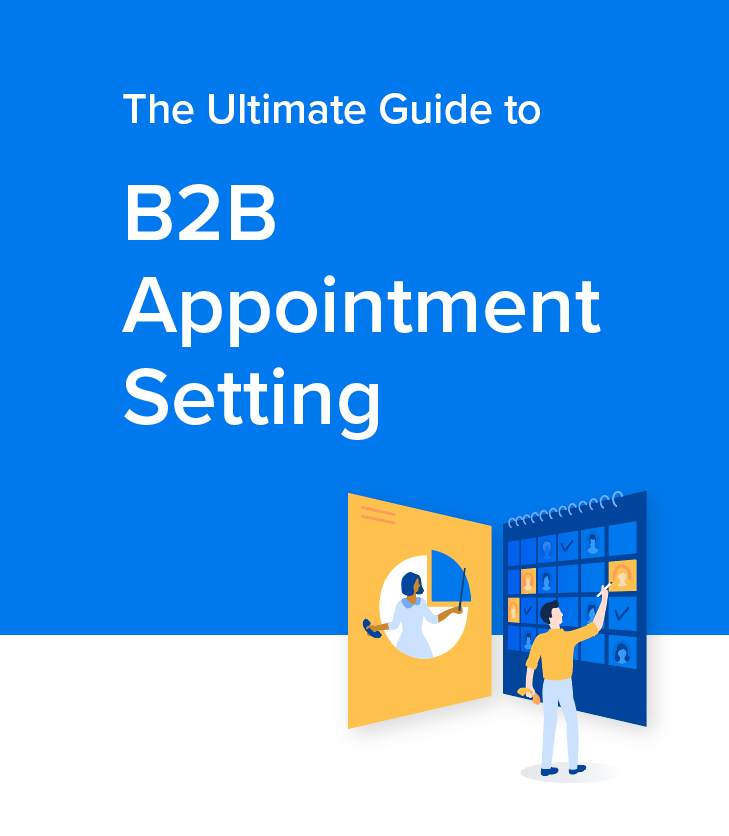Connect with a Consultant
Fill out your information with the form provided and one of our team members will reach out to you shortly.

This post was originally published in July 2018 and has been updated for accuracy and comprehensiveness.
Understanding who and how to target prospects is just the first step. Now, it’s time to build the engine that propels your sales development efforts. In this chapter, we’ll go through how to build an effective SDR team.
We’ll go over:

Don’t have time to read the full guide right now? Download the Ultimate Guide to B2B Appointment Setting to read at your convenience.
While every organization’s appointment-setting goals may look different, the general SDR team structure should look like this:

Drives high-level strategy and ensures the team is creating efficient pipeline growth

Oversees day-to-day operations and provides tactical support

Cold calls, qualifies leads, and sets appointments for the sales team
Your management team should offer three layers of management: strategic, tactical, and operations. By doing so, you’ll ensure each SDR is trained on your standardized best practices — all while ensuring you’re working together towards a singular business goal.
EBQ Tip: Hiring each appointment setter is costly. You need to invest in medical benefits, retirement fund options, tech stacks, and devices. Additionally, every hire is a gamble on whether they are the right fit to ensure your project’s success. Many organizations choose to outsource their sales development team instead to push costs down while keeping productivity high. Before you partner with a sales team, make sure you check out “11 Things to Consider Before Choosing an Outsourced Lead Generation Service.”


One of the first questions people often ask us is, “How many SDRs should I hire to support my sales team?”
The answer depends on your goals, your product’s complexity, and your sales cycle length. Translation? There is no magical SDR to AE ratio to guarantee success.
That said, here are a few SDRs to AE ratios to consider:
One-to-one (1:1) – This ratio is a good starting point for many companies and allows a close, direct relationship between the sales rep and the SDR qualifying their leads.
Two-to-one (2:1) – Having two SDRs for each sales rep means the rep gets twice as much pipeline built for them daily. This is helpful for companies with smaller deal sizes, quicker sales cycles, and a highly sought-after offering.
One-to-two (1:2) – Having one SDR for multiple sales reps is useful when your pipeline is generally slow to build but sales cycles are longer and more involved and closed deals have a higher cost.
Regardless of what SDR: AE ratio you choose, we highly recommend taking proactive steps to align your SDRs and sales team. Typically, we recommend that you assign an SDR to a sales rep. That way, you can boost their team morale, keep consistent results, and track their progress more effectively.
An all-bound SDR team mixes inbound and outbound sales development activity into one team. Outbound activity typically encompasses all cold outreach attempts — including phone calls and emails.
On the other hand, inbound activities involve all follow-up attempts on warmer leads. The benefits of following up on warm leads are:
We find that combining both inbound and outbound activities in one team is crucial for reduced SDR attrition. After all, handling cold and warm leads balances out the high rejection rate of cold calls with better conversion rates of warm leads — leading to better morale.
Your first step to effectively manage an SDR team is to adopt a process-driven management approach. That way, you can make sure everyone’s on the same page when it comes to:
To make sure everyone is on the same page, make sure to document your best practices in an SDR playbook. Your playbook should include great talk tracks based on specific buyer personas.
Next, make sure you hire the right SDR manager to lead your appointment-setting team. We recommend promoting an SDR from within, as they can truly empathize with their subordinates. They’ll be able to better train your SDRs because they understand the unique appointment-setting challenges.
After choosing who is going to lead your SDR team, it’s time to select who else to hire. When determining who to hire as an SDR, we recommend looking into three things: personality, experience, and transferable skills.
From our experience, personality should be your biggest consideration. Think about it: your SDRs are the face of your brand. They are the people your prospects interact with first. You want someone personable, amiable, and confident to start these conversations on your behalf.
Next, take a look at their experience. Because appointment setting is typically an entry-level position, a candidate’s work history doesn’t need to directly relate to sales development.
For example, we’ve seen exceptional performance from reps who previously worked in the service industry — another job that requires polished communication skills.
As for skills, look for someone with the following abilities:

If you’re looking for additional resources on hiring SDRs, check out our on-demand webinar. Our COO, Michael Edwards, walks through the building blocks to forming your internal appointment-setting team.

Don’t have time to read the full guide right now? Download the Ultimate Guide to B2B Appointment Setting to read at your convenience.
Creating an appointment-setting team is all about finding the right SDR-to-AE ratio and hiring the right people. But there is a huge gamble in creating an internal team of sales development representatives. You need to find the best leader for your SDR team and attract the right people to not only join your team but also stay in your organization.
It’s why people choose to outsource their sales development team. You get a built-in management layer and bypass all the HR responsibilities of hiring internally. Visit our Appointment Setting page to learn more.
Fill out your information with the form provided and one of our team members will reach out to you shortly.
6800 Burleson Road
Building 310, Suite 265
Austin, TX 78744
©EBQ 2023 All rights reserved.
Tell us about yourself and we’ll get in touch shortly.
